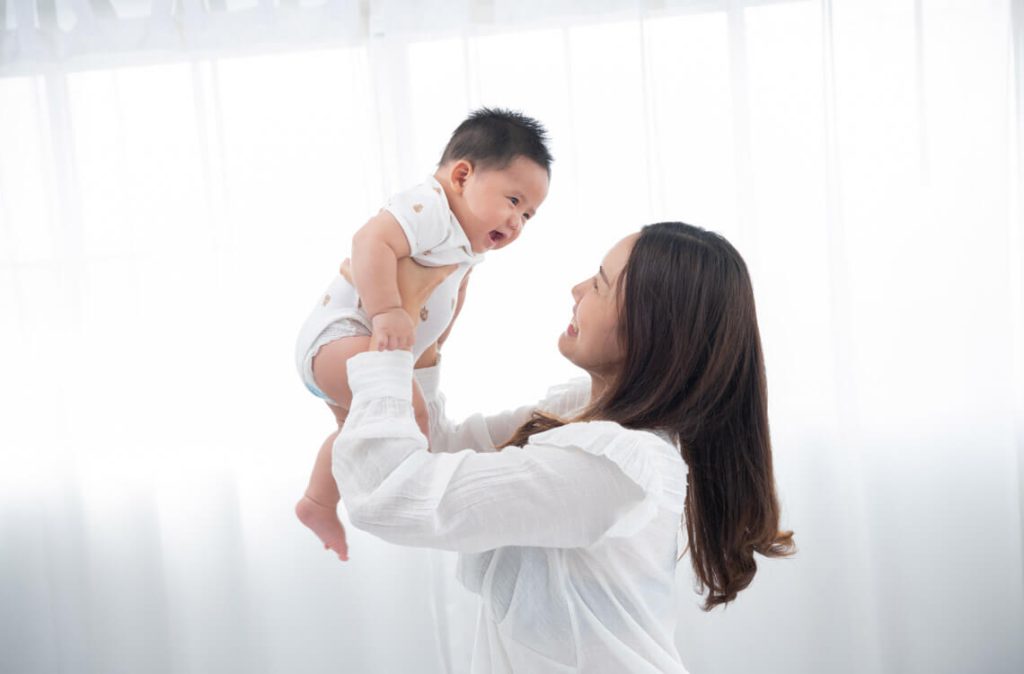Your baby is now reaching their 6-month-old developmental milestones. Suddenly, they feel less like a tiny infant and more like an active, curious companion.
Sitting, rolling, babbling, and reaching become everyday features. Their personality also blossoms, with more laughter, excitement, and even the occasional pout.
This halfway point of the first year often feels like a turning page. Meals start to include new tastes, playtime becomes more adventurous, and social bonds deepen.
Let’s explore what to expect at this stage, how to encourage growth, and when to seek extra support.
Physical & Motor Milestones
Sitting with Less Support
By six months, many babies can sit briefly without much help.
Some may still wobble or topple, while others sit confidently for short periods. Sitting builds stronger back and core muscles, preparing them for crawling.
Give your baby time to practise on a soft surface with cushions for safety. Sitting between your legs offers support and reassurance.
Rolling and Starting to Move
Rolling from tummy to back and back to tummy is now more consistent.
Many babies also begin pivoting in circles on their tummy or rocking back and forth, early signs of crawling readiness. Expect more mobility — which means baby-proofing becomes urgent.
Place toys just out of reach to motivate movement. Celebrate effort as much as success, since trying is part of the learning.
Communication & Cognitive Development
Babbling with Variety
Your baby’s babbling may now sound more like speech. Strings of sounds such as “ba-ba” or “da-da” are common.
These aren’t words yet, but they show your baby is experimenting with language rhythm and tone.
Respond with enthusiasm. Imitate their sounds, speak in short sentences, and introduce simple words during daily routines.
Recognising Patterns and Memory Growth
At six months, babies recognise familiar faces more clearly and may show excitement when someone they know enters the room.
They also begin to remember routines. For instance, they may get excited when you bring out a bib, knowing feeding is next.
Play simple games like peekaboo, which teach object permanence — the idea that things still exist even when hidden.
Social & Emotional Development
Stranger Anxiety Begins
Some babies at six months start showing wariness around unfamiliar people. They may cling to a parent or cry when approached by someone new.
This is a normal part of attachment development and shows that your baby knows who their closest carers are.
Offer reassurance by holding them close in new settings. Allow them time to warm up to others at their own pace.
Expressing Feelings More Clearly
Your baby now communicates joy, frustration, and even protest more vividly.
Expect louder giggles during games, squeals when excited, and frowns or cries when displeased. This emotional range is healthy and part of building trust in expressing needs.
Acknowledge their feelings with calm words: “I see you’re upset” or “That made you laugh.” This builds emotional understanding.
Sensory & Perceptual Development
Exploring with Hands and Mouth
Babies at six months use their hands with more purpose. They can pass objects from one hand to another and bang toys together.
They also continue exploring with their mouths, so keep toys safe and clean.
Offer teething rings, textured toys, or soft blocks. These support sensory learning and soothe gums as teeth begin to emerge.
Sharper Listening and Response
At this stage, babies often respond when called by name. They recognise familiar voices and may turn towards them with excitement. Many also quiet when they hear a soothing song or lively rhyme.
Use repetition and rhythm when talking or singing. Babies thrive on predictable sounds and patterns.
When to Talk to a Paediatrician
Check with your paediatrician or health visitor if your baby:
- cannot roll in either direction.
- has very poor head or upper body control.
- shows little interest in social interaction or play.
- does not respond to familiar sounds or voices.
- struggles to grasp or hold objects.
These signs don’t always point to problems, but seeking advice early provides reassurance and support.
Give your little one plenty of time to achieve their 6-month-old developmental milestones before you panic If they’re still behind, consult a doctor.
Expert Tips & Daily Activities
Play with Purpose
Offer safe floor play every day. Encourage rolling, reaching, and pivoting. Rotate toys often to keep interest high.
Reading and Songs
Choose sturdy board books with bright pictures and read daily. Add hand actions or clapping songs to keep them engaged.
Tasting New Foods
Around six months, many babies are ready for solids alongside milk. Start with smooth purées or soft finger foods if advised by your health visitor. Make it playful (messy is part of learning).
Outdoor Exploration
Take your baby out in a pushchair or sling. Point out trees, dogs, or passing buses. Fresh air and new scenery stimulate both mind and body.
A Whole New World
At six months, your baby is transforming into an active, social little explorer. Sitting, rolling, babbling, and playing all signal growing independence.
Your baby’s 6-month-old developmental milestones is full of laughter, discovery, and sometimes a few tears, but it’s all part of the journey.
Celebrate the little milestones and trust the process. Your warmth, encouragement, and presence matter most as your baby discovers this brand-new world.
Disclaimer: The information provided in this article is for informational purposes only and should not be considered as medical advice from Motherhood. For any health-related concerns, it is advisable to consult with a qualified healthcare professional or medical practitioner.
For more insightful stories and fun recipes, stay tuned to Motherhood Story!
